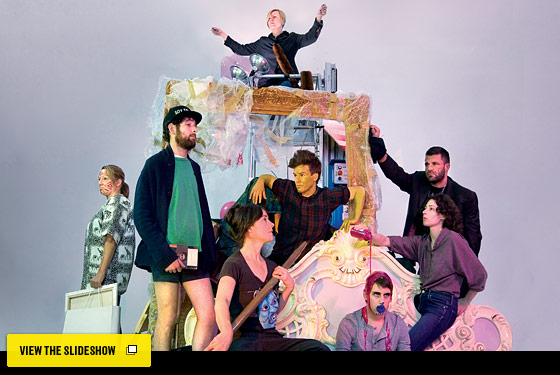
Eight young artists whose work the critic believes breathes new liveliness into a frustrating system, in a photograph by one of them, Ryan McNamara. Who are they? Click to view the slideshow.
Art is changing. Again. Here. Now. Opportunities to witness this are rare, so attend and observe.
For nearly ten years, starting in the late nineties, art and money had sex in public. Lots of it. And really publicly. Art became news. Prices were equated with artistic value. The highest sellers were seen as the best artists. Galleries got bigger, then became multinational, opening branches here and then in Europe and Asia. Wherever money went, art followed (it should be the other way around). Larry Gagosian now has eleven outposts; I await Gagosian Kuwait.
Like oil wells, once these operations are turned on they have to keep pumping product. Lots of it. Most of it crude. For ten years, large, shiny, highly produced, entertaining, ever-more-expensive objects were produced by the system, then snapped up by speculator collectors who rushed in where the rest of us feared to tread. It doesn’t matter that most of them don’t know what art really is and have never gleaned its hallucinatory powers. A lot of people struck it rich and laughed all the way to the bank.
This worldwide rising tide had the benefit of floating many boats. More artists than at any time in history were able to at least subsist within this system. And a lot of very good art got made. So it went. Until it didn’t. In 2008, the bubble burst. Or seemed to. Everyone, including me, assumed that the art world would shrink. But that didn’t happen. Instead, growth surged. It was as if John Travolta’s Pulp Fiction character stabbed the art world in the heart with a giant adrenaline needle! More sales and speculators; higher prices; new galleries. And it’s still happening. Even as the world is in recession, the art world has remained on a bender.
But something has been happening of late. Large numbers of disconnected and discontented artists, gallerists, and others have taken matters into their own hands, changing the directions of art, its structures, and maybe its internal values. Over the last decade, we saw megatons of art that was produced in factories, turned out by armies of assistants, and sometimes never touched by its makers. All you could think about was how much it cost. Collectors and museum curators eager to be included in the all-out global party shelled out enormous amounts of money for this sort of art. Often they bought it sight unseen. Everything was impersonal. Meanwhile, things small, unfinished, or chaotic were art non grata.
But now, all of a sudden, more art is coming from private places, looking almost outsiderlike, untaught, odd in ways that feel pressing, impatient, and important. In from the wilderness. A lot of it is smaller, made of less expensive or found materials, and more provisional, or at least bad in ways that aren’t so annoying.
After too much art that made too much sense, artists are operating blind again. They’re more interested in the possible than the probable, the private that speaks publicly rather than the public with no private side at all. Damien Hirst may be able to fill eleven galleries with spot paintings done by other people for other people. But this work doesn’t have any of the inner power channeled by Joanna Malinowska, staging a concert of Beethoven’s Moonlight Sonata played on toy pianos, then inviting over 100 viewers to howl like wolves for five minutes, mourning the fate of Native American prisoner Leonard Peltier.
Much of this art evades categorization and defies collectors. It exists in the in-between genres where performance, sculpture, video, sound, photography, and sometimes painting overlap. When it’s not in an overlap, it jolts the old categories. I see artists bored by light-without-heat, irked at gigantic galleries’ pushing out art-as-product, leaving behind the overdetermined for the undetermined, guided by interior voices and bringing us out of a long tunnel to new blueness. Our blood still boiling at the art-luxury freak show, insurgent energies have resolved to make it new and make it over. Or die trying.
And the pheromones in the streets have been wild. There have been evenings of over twenty openings in little spaces on the Lower East Side and in Bushwick, enormous numbers of people filling the streets, looking at one another as if to say, “Yeah. There’s a way around the grossness and shell shock.” Most important, it’s not about neighborhoods or size. Energy and art go where they will. Peter Freeman just opened a huge, unrenovated ground-floor space on Grand Street that looks and even smells so much like an old Soho loft gallery it gave me old-school goose bumps.
Hundreds came, dozens of works were hung, and dancing in the streets ensued a few weeks ago at the opening of artist Hennessy Youngman’s everybody-is-welcome-and-everything-gets-hung open-call show at Maurizio Cattelan and Massimiliano Gioni’s new pint-size Chelsea non-gallery, Family Business. Cattelan recently hung his career’s output from the ceiling at the Guggenheim for a retrospective, and the New Museum’s Gioni is the curator of the next Venice Biennale; that two bigwig insiders are running this peewee nonprofit space in the middle of Chelsea shows people are still trying at all costs not to go along to get along and to play with the system instead.
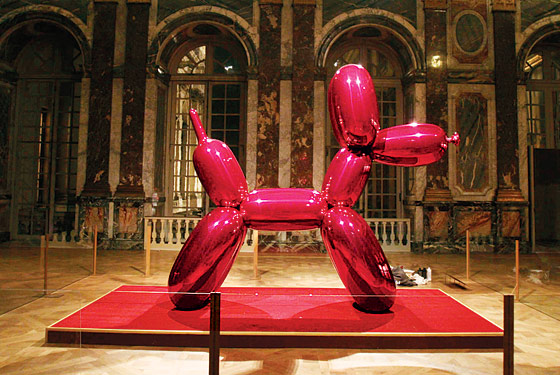
Three weeks earlier, I’d seen Marie Lorenz’s extraordinary show at Jack Hanley, which includes videos of the artist rowing a small homemade boat around the rivers, waterways, and bays of New York City, exploring unknown reaches of the city, landing on unpeopled beaches. The work is personal; there’s nothing corporate about it. It’s not a commodity—it’s hardly a thing at all. Quietly insubordinate and seditious, Lorenz is a one-woman nomad, reimagining the city, letting us see New York anew through a larger, more mysterious lens.
Not long after, I watched Sarah Michelson journey into time and whirling-dervish-dom at the Whitney, choreographing her dancers to twirl in unison, mirroring one another’s movements in widening gyres. A dozen people walked out. Yet I saw many happily breathe in. A similar thing happened at Derek Eller Gallery as Liz Magic Laser had two actors mime the body languages of Barack Obama and George H.W. Bush giving speeches. In this small gallery, no one left; instead a room full of people gaped. Alex Israel’s videos have left me similarly speechless: Israel reads deadpan questions to people like Phyllis Diller, Paul Anka, James Caan, Marilyn Manson, and Jamie Lee Curtis, asking them non-things like, “What do you like to do to pass time on a long flight?” and “Is all fair in love and war?”
At the peak of these personal mountains is the late Mike Kelley’s tremendous three-and-a-half-hour unfinished Whitney Biennial film. We see a mobile-home replica of Kelley’s Detroit childhood house being driven up and down a long stretch of Detroit’s Michigan Avenue. Along the way, Kelley’s interviews with everyday people are spliced in, folks trying to get along, living lives in unique, amazingly creative ways. Watching it, I saw documentary film sprouting new tentacles. Kelley had the instinctive understanding that reality isn’t just something that can be made into art. If seen in the right way, everything already is art. His loss is huge.
Some see the fissuring as the split between market and anti-market forces. Yet we all claim to be on the same side. Nobody is willing to admit to being Establishment anymore, since at this point the Establishment itself acknowledges that all the energy is on the romantic fringes. Even Jeff Koons, whose work is utterly salable, is about art first, at the same time that he’s trying to create a $25 million hanging-locomotive sculpture to hover above the High Line. Hirst, maker of the $100 million skull bauble, says, “Art is more powerful than money.” And those of us who claim to shun or be shunned by the market exist in a larger system that rewards us with money, time, space, grants, residencies, recognition, or respites from full-time-job hell. Not to sound like a holistic hippie, but there are no insiders and outsiders anymore; everyone is both at once.
Now, of course, there remain many dinosaurs, lingering on after the meteor strike. It’s hard to imagine the purpose of Zhan Wang’s huge stainless-steel copies of a 1,000-year-old Chinese scholar’s rock, other than as swimming-pool sculpture or lobby decoration. What possible meaning can we ascribe to the kicked-over motorcycles by Dan Colen, smiley faces by Fang Lijun, or happy, shiny garnishes by Takashi Murakami and Hirst. The era of boat-size paintings and sculptures, spotless installation extravaganzas, and other lobbylike spectacles produced by well-funded artists and teams of assistants may thankfully be fading. A few craven museum directors and a handful of dealers will fight to hold on to this sort of work. May they all thrive in Dubai.
Not to say people shouldn’t get rich from art. I adore the alchemy wherein artists who cast a complex spell make rich people give them their money. (Just writing it makes me cackle.) But too many artists have been making money without magic. This isn’t alchemy; it’s cagey gamesmanship and clever complacency. And it’s trickled down. These days, newish art can be priced between $10,000 and $25,000. When I tell artists that a new painting by a newish artist should go for around $1,200, they look at me like I’m a flesh-eating virus.
It remains to be seen whether high prices are the global warming of the art world, imperiling an entire ecosystem. Perhaps the planet will adapt. Perhaps not. But shouldn’t we be alarmed that one work by Murakami now costs more than masterworks by Constable, Courbet, Delacroix, Fuseli, Géricault, Ingres, Rubens, and Turner combined? It’s not a joke: I know markets are mirages and unrelated, but good work by all of these older masters recently sold for a total of around $3 million; one Murakami fetched over $15 million. From an edition of three. Plus two artist’s proofs.
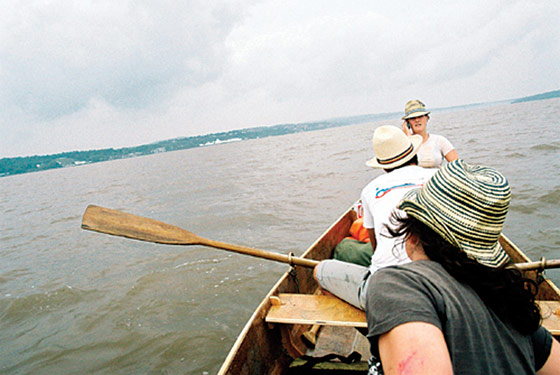
Then there are art fairs. Gallerists bemoan them but still do four, five, or six art fairs a year. None is cheap. Artists churn out work for fairs. Collectors come and spend bundles of money. Last month there were a dozen art fairs in New York. Next week the first New York Frieze Art Fair arrives, and the NADA fair too.
In the early nineties, when the now-gigantic beast known as the Armory Show started small, cheap, and out of control as the Gramercy International Art Fair, I loved it. I loved watching the then-unknown English artist Tracey Emin in a hotel bed under a quilt of her own making, recalling past lovers; listening to L.A. artist Jason Rhoades, a human Bam-Bam, spew out new sculptural terms; wearing one of Andrea Zittel’s sheath dresses for an hour at the fair, being secretly amazed at how sexily exposed it made my genitals feel and wondering whether women feel this way.
In the last decade, art fairs mushroomed and became all-encompassing, fully comped VIP monstrosities and entertainment complexes for the one percent. So I went off art fairs. Way off. I’ve never told anyone this, but I hit my art-fair bottom at Art Basel, in Switzerland, where I was invited to be on a panel in the mid-aughts. I checked in alone to a hotel and had a meltdown. Feeling alienated, realizing a critic had no business there, intimidated by the socializing yet afraid to be excluded, I freaked out. I made up a story about an imminent death in my family, packed, and flew home early. I’ve been too scared to ever leave New York for an art fair again.
But I’ve made peace with them. Last month I went to seven local fairs. I’ll go to Frieze and NADA in May. I’ll smile. I now like leaving my office and refrigerator, putting on real clothes, facing the larger world. Sometimes good art jumps out at me; most of the time I see bad art, or see nothing at all and just drift, feeling weird, pretending to be fine. We all call temporary truces with these events. We agree the conditions are horrible and overexposed but grant that time speeds up here, people meet each other faster, in the flesh; some dealers report making as much money at an art fair as they make all year. Now I view art fairs as cultural-biomasses: survival mechanisms where galleries act like great schools of fish, banding together in like groups that allow more to thrive, confusing and eluding predators. At art fairs, art becomes like millions of eggs released into water to have a better chance at being fertilized. This means that collectors are semen, but whatever.
And from the looks of the list of galleries participating in the upcoming Frieze Art Fair, which will be held in a tent on Randall’s Island, this event could easily revitalize and redefine the nature of an art fair, returning us again to the idea of fair as tribal powwow. All I know is that this is the first time I’ll happily be crossing water for one since my Basel debacle. Let’s touch whiskers there.
Which brings us back to the ways the art world is breaking down and remaking itself—cannibalizing itself, always hungry for the new. While official, moneyed, and institutional tastes dither, as collectors buy what other collectors buy and teachers teach what other teachers have taught, art has crept into and expanded the cracks, opening vents and secret pathways. With money and academics distracted, different artists, ideas, and activities are getting more psychic time and space to root; older and overlooked artists are getting second chances; artists can grow wild again. They are more and more speaking the passwords primeval.
And the art world is having a quiet, collective Archimedes-eureka moment. We’ve been in this tub of brackish water for a while, feeling frustrated with the business of art, sometimes hopeless and uninspired, wondering what can be done. Now people realize that if we’re all already in the tub (e.g., the system), we’re already displacing water. The spill-off will be as great as what goes into the tub. Everybody in!
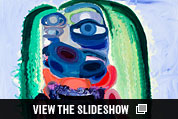
There Are No Rules
These eight young artists are breaking the barriers between genres, bringing sculpture into performance, performance into everyday life, and unfurling new worlds.
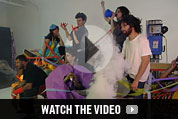
Watch a Behind-the-Scenes Video of the Photoshoot
E-mail: [email protected].

Eight young artists whose work the critic believes breathes new liveliness into a frustrating system, in a photograph by one of them, Ryan McNamara. Who are they? Click ahead. Photograph by Ryan McNamara

McNamara says, “Each artist chose a method to somehow connect themselves to at least one other person. I went into the shoot really hoping someone would be willing to hang upside down from the cherry picker. I was out of the running as I needed to stay mobile in order to check the camera after each shot, so thankfully Keltie was game.” Photograph by Ryan McNamara

“I asked the artists to use props and their own bodies to create a piece that would fit within their body of work. I had just spend three weeks lighting and photographing gallery visitors for my show so I shined flashlights on Katherine and Bjarne.” Photograph by Ryan McNamara
